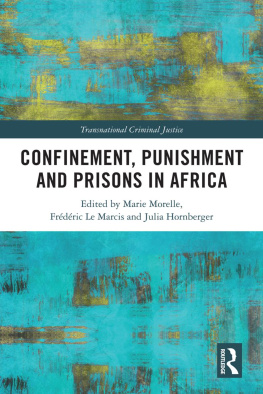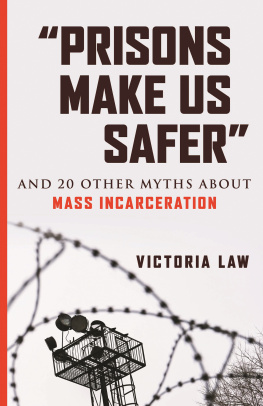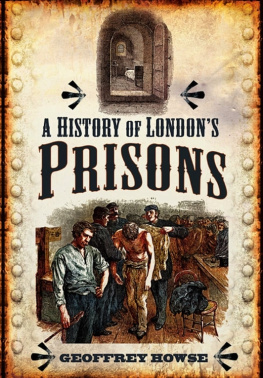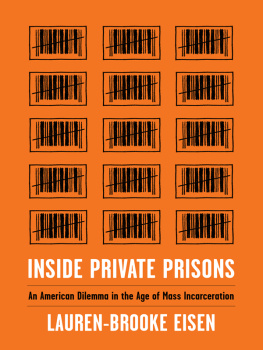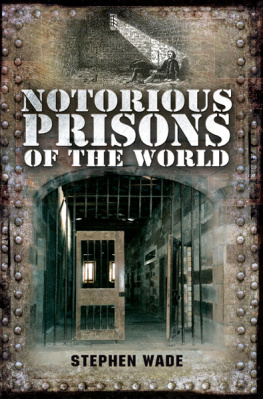Incarceration and Regime Change
Incarceration and Regime Change
European Prisons during and after the Second World War
Edited by
Christian G De Vito, Ralf Futselaar and Helen Grevers
Published in 2017 by
Berghahn Books
www.berghahnbooks.com
2017 Christian G. De Vito, Ralf Futselaar and Helen Grevers
This book has been realised with the support of the IAP
Justice & Populations (PVII/22), Interuniversity Attraction Poles Programme Belgian Science Policy Office.
This books contributions were first developed in preliminary form as part of the NIAS/NIOD Exploratory Workshop Internment, Incarceration and Detention. Captivation Histories in Europe around the First and Second World Wars, held 3-4 November 2011 in Wassenaar, the Netherlands.
Ralf Futselaar contributed to this book within the context of the research programme Four Centuries of Labour Camps. War, Rehabilitation, Ethnicity, which is financed by the Netherlands Organisation for Scientific Research (NWO).
All rights reserved. Except for the quotation of short passages
for the purposes of criticism and review, no part of this book
may be reproduced in any form or by any means, electronic or
mechanical, including photocopying, recording, or any information
storage and retrieval system now known or to be invented,
without written permission of the publisher.
Library of Congress Cataloging-in-Publication Data
Names: De Vito, Christian G., editor. | Futselaar, Ralf, 1976- editor. | Grevers, Helen, 1986- editor.
Title: Incarceration and regime change : European prisons during and after the Second World War / edited by Christian G. De Vito, Ralf Futselaar, and Helen Grevers.
Description: New York : Berghahn Books, 2017. | Includes bibliographical references and index.
Identifiers: LCCN 2016022580 | ISBN 9781785332654 (hardback : alk. paper)
Subjects: LCSH: PrisonsEuropeHistory20th century. | Prison administrationEuropeHistory20th century. | World War, 19391945Prisoners and prisons, European.
Classification: LCC HV9637 .I53 2017 | DDC 365/.9409044dc23
LC record available at https://lccn.loc.gov/2016022580
British Library Cataloguing in Publication Data
A catalogue record for this book is available from the British Library
Printed in the United States on acid-free paper
ISBN 978-1-78533-265-4 hardback
ISBN 978-1-78533-266-1 ebook
Contents
Introduction
Incarceration and Regime Change
Christian G De Vito, Ralf Futselaar and Helen Grevers
Chapter 1
Gloomy Dungeons: Provisional Prisons in Madrid in the Aftermath of the Spanish Civil War (193945)
Alicia Quintero Maqua
Chapter 2
Paradoxical Outcomes? Incarceration, War and Regime Changes in Italy, 194354
Christian G De Vito
Chapter 3
Life in the Frontstalags: Colonial Prisoners of War in Occupied France, 194042
Sarah Frank
Chapter 4
Containing Potentially Subversive Subjects: The Internment of Supporters of the National Socialist Movement in the Netherlands Indies, 194046
Esther Zwinkels
Chapter 5
The Detention of Social Outsiders between Social Reform, Annihilation and Custody: The Municipal Workhouse and Prison of Berlin-Rummelsburg from Weimar Republic to GDR
Thomas Irmer
Chapter 6
A Triumph for the Protectional Model? How Belgian Institutions for Delinquent Children Dealt with Young Collaborators (194450)
Aurore Franois
Chapter 7
The Ambiguities of Gendarmeries Relationship to Internment around World War II (Belgium, France, the Netherlands)
Jonas Campion
Afterword
An Essay on Space and Time
Jane Caplan
Introduction
Incarceration and Regime Change
Christian G De Vito, Ralf Futselaar and Helen Grevers
In July 1944, the German SS began evacuating the Konzentrationslager Herzogenbusch. During their last months in control of the site, 329 prisoners were shot, and many others were put on a transport to Germany. Many among the latter group would not survive. When the southern Netherlands fell into Allied hands in autumn of 1944, the former Nazi concentration camp became a Dutch internment camp, at its peak holding 6,000 German citizens and 6,000 Dutch collaborators. Today, the former camp area is largely taken up by a high-security prison. Sites of incarceration are often remarkably long-lived and often survive multiple regime changes.
In the aftermath of liberation, the erstwhile concentration camp was a mess. Compared with the number of prisoners interned there, both supplies and (trained) staff were dramatically low. The disgruntled camp commander, a member of the former Dutch resistance, complained that the Nazis had organized camp life much better when they had been in charge.the Nazi empire crumbled, sites of incarceration were changing hands rather than being dismantled.
Over the last two decades, a small but interesting literature has emerged that focuses on the various forms of incarceration during and immediately after World War I and World War II. States expanded their control over society, and incarceration was a preferred means for exclusion, social engineering and covert execution. Especially in and around times of war, these changes led to massive increases in the numbers of people confined to prisons or prison-like institutions.
This volume seeks to add to this small but growing field by investigating the impact of wartime regime change on the forms, objectives and experiences of incarceration. More specifically, the seven essays that follow explore not only the ways in which inmates, prisoners and internees were treated, but also how they were conceptualized; societies in these times of extreme instability constructed images of their inmates. These conceptualizations of prisoners developed amidst often conflicting policies, existing or newly introduced penal cultures and insecure jurisdictions. Through their shared focus on the places of incarceration, rather than on the practices of any particular regime, these chapters can reveal continuities that have escaped most, if not all, other publications in the field.
Although political prisoners necessarily play a large role in all of these chapters, the chapters also aim to correct the overrepresentation of release and incarceration of various political prisoners in the literature, by highlighting the profound impact that regime changes had on non-political prisoners as well. Of course, that does not, and should not, detract from the inmates who were imprisoned because of their (real or ascribed) role in armed or political conflict. Yet we hope to focus on all captive men and women who experienced internment, imprisonment and detention. Prisoners, whether political or not, often went through multiple institutions and to an extent shaped them, just as they influenced the ways in which they themselves and their former places of confinement were represented and remembered after and during the transitional period.
A Note on Theory
It is unbecoming to editors to hijack the empirical work of contributors to mount their theoretical or ideological hobby horses in their introduction, but in this case a few remarks are in order. The field of prison history is but a miniscule element in the vastness of modern historiography. That is to say, empirical studies into the history of incarceration are relatively rare. Because of the work of (especially) Michel Foucault, however, it has nevertheless become an important focal point of social and historical theory and debate. There likely is no other field in historical enquiry that is so top-heavy, where such grand, and sometimes grandiose, theories have been grounded on such a small empirical research tradition. When thinking about state power in particular, it seems modern historians cannot quite escape from prisons.


